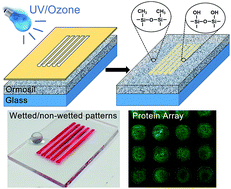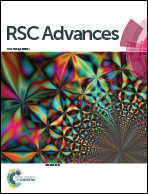Robust superhydrophilic patterning of superhydrophobic ormosil surfaces for high-throughput on-chip screening applications†
Abstract
This article describes a facile method for the preparation of two-dimensionally patterned superhydrophobic hybrid coatings with controlled wettability. Superhydrophobic coatings were deposited from nanostructured organically modified silica (ormosil) colloids that were synthesized via a simple sol–gel method. On the defined areas of the superhydrophobic ormosil coatings, stable wetted micropatterns were produced using Ultraviolet/Ozone (UV/O) treatment which modifies the surface chemistry from hydrophobic to hydrophilic without changing the surface morphology. The degree of wettability can be precisely controlled depending on the UV/O exposure duration; extremely wetted spots with water contact angle (WCA) of nearly 0° can be obtained. Furthermore, we demonstrated high-throughput biomolecular adsorption and mixing using the superhydrophilic patterns. The proposed superhydrophilic-patterned nanostructured ormosil surfaces with their simple preparation, robust and controlled wettability as well as adaptability on flexible substrates, hold great potential for biomedical and chemical on-chip analysis.


 Please wait while we load your content...
Please wait while we load your content...